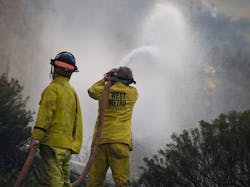Take Precautions Now; Wildfire Risk Predicted to be High in 2013
With a mild winter, relatively warmer weather in general, and drought conditions expected to continue in 2013, the Insurance Institute for Business & Home Safety (IBHS) urges home and business owners to take action now to effectively reduce their wildfire risk.
“Wildfire losses have been on the rise during the past couple of years in several states, with Colorado, Texas and Wyoming being particularly hard hit,” noted Julie Rochman, IBHS president and CEO. “2013 is shaping up to be another very dangerous year, because of a combination of weather-related factors.”
According to State of the Climate, released by the U.S. National Oceanic and Atmospheric Administration (NOAA), 2012 was the warmest year on record in the contiguous United States. The average temperature in 2012 was a full degree higher (55.3 degrees Fahrenheit) than the previous record set in 1998.
In addition, warm temperatures were coupled with severe drought. Last year was the driest year in the contiguous United States since 1988, according to NOAA. In Nebraska and Wyoming, it was the driest year on record. For 2013, 10 states are already experiencing “exceptional drought” conditions, while snow levels throughout the country are nearing record lows, according to the National Drought Mitigation Center.
The National Interagency Fire Center reports that more than 67,000 wildfires burned more than 9.2 million acres throughout the country in 2012. This was the third-largest number of acres burned in the United States during the 13-year period of record. Warm temperatures and drought conditions will both contribute to an increase in the risk of wildfire this year.
“It is critical that individuals and communities vulnerable to wildfire act now to reduce their risks,” Rochman stated. “Property owners can use our effective risk-reduction tools to build what is essentially a ‘self-defense’ system for their property during a wildfire. By doing so, they can evacuate if necessary and still hope to find their home or business intact after a fire moves through the area.”
- IBHS wildfire resources are available at DisasterSafety.org. Specific resources include:
- IBHS Wildfire Home Assessment & Checklist
- IBHS Wildfire Brochures: Residential and Farms and Ranches
- IBHS Regional Wildfire Retrofit Guides
IBHS is a leading national expert on preparing for and repairing and rebuilding structures after a catastrophe to make them more disaster-resistant.
About the Author

Sandy Smith
Sandy Smith is the former content director of EHS Today, and is currently the EHSQ content & community lead at Intelex Technologies Inc. She has written about occupational safety and health and environmental issues since 1990.
